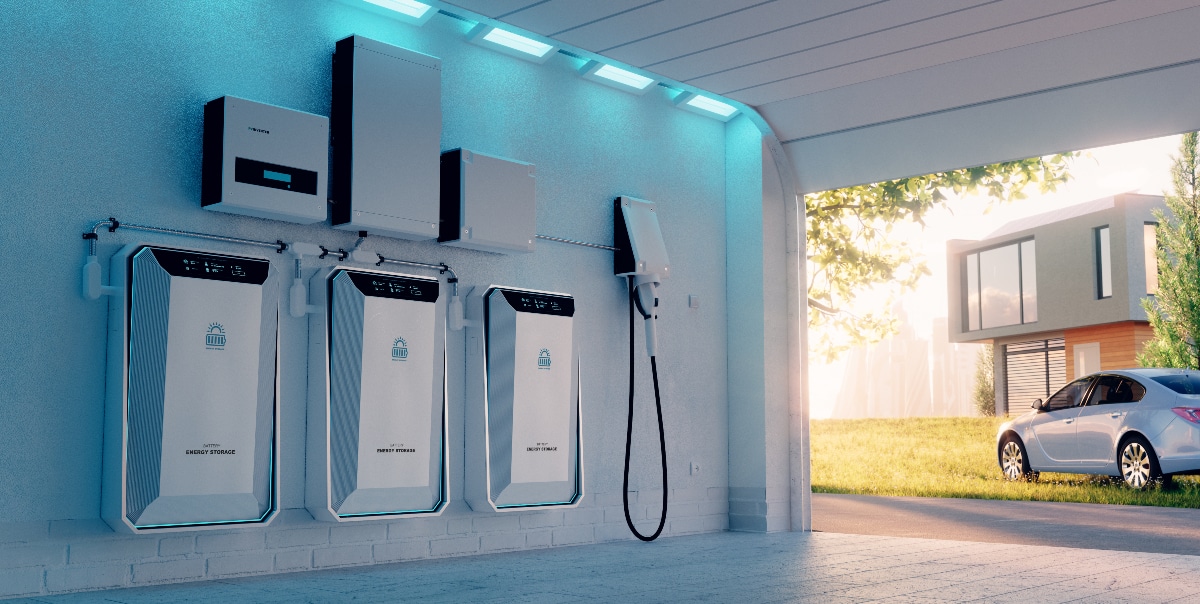A Complete Guide to Electrification

5 Min. Read
Electric vehicles (EVs) and solar panels are the first things that come to mind when electrification comes up. However, homeowners can explore other options to adopt a sustainable and self-reliant lifestyle while lowering energy costs.
Fossil fuel dependence is a significant challenge we need to overcome. Taking a comprehensive approach to electrification is the best way to build a cleaner future.
EVs and solar panels
The gas you put in your car and the electricity you use at home are two things that increase your carbon footprint. It’s no secret that vehicles emit CO2 and other greenhouse gases. With more people and goods on the move, transportation accounts for 17% of global emissions.
Depending on your local utility company, the energy you use at home may or may not be clean. Utility companies are taking steps to reduce their natural gas use, but nuclear power and renewable energies account for only 20% of all electricity produced in the U.S.
The EV revolution
The U.S. currently produces 80 quadrillion British thermal units of fossil fuels, with gasoline representing a significant percentage. Driving an EV is one of the best things you can do to help the environment.
Newer cars pollute less, but a vehicle with a rating of 50 mpg still emits the equivalent of 3.6 tons of CO2 each year between tailpipe and upstream emissions. It’s possible to eliminate tailpipe emissions and reliance on fossil fuels with an EV.
Solar energy
Solar power is another popular electrification trend, with 121 Gigawatts of solar capacity available in the U.S. Utility companies are leading the way, but residential customers are also investing in solar.
Innovations in solar panel technologies make solar systems higher-performing and more affordable than ever. Solar power is creating jobs. It’s also reducing reliance on the local energy grid and can help save $10,000 to $30,000 over the total lifespan of a solar energy system.
Electrical appliances and building electrification
Home electrification is the next step for those looking to reduce their environmental footprint and save money.
Cleaner appliances
Switching to electric water heaters, dryers and stoves is an easy way to use fewer fossil fuels. Electric appliances provide some immediate benefits.
Water heating represents 20% of a home’s energy use. Natural gas can be cheaper, but this fossil fuel is harmful to the environment. It can also release carbon monoxide and pollutants into your indoor air. Electric water heaters are safer, more efficient and easier to install. Plus, you’ll save on maintenance since fewer things can go wrong.
Heating and cooling
Your heating and cooling system is another feature you can electrify. Explore different options with electric furnaces, electric heat pumps or baseboard heaters. These appliances are energy-efficient and very quiet.
Rethinking the way we heat buildings is essential. Heating represents around half of residential and commercial energy consumption. Experts predict that CO2 emissions linked to heating will increase another 5% by 2026.
Whole building projects
Building electrification can pave the way to a greener future. However, it’s a complex challenge, with 26 million low-income households depending on fossil fuels for heating. Renters struggle to access upgrades and retrofit programs.
Electrification also yields better results when homeowners go beyond installing cleaner appliances. A building retrofit project typically includes upgrading the envelope, improving ventilation and adding more insulation. For multi-family buildings, compartmentation is a viable strategy for reducing energy use.
Going further with a smart energy grid
Recent innovations are opening new doors for storing and accessing energy. As electrification grows in importance, local governments and utility companies will have to upgrade the electricity grid to meet the increase in demand. However, options are also available to homeowners and EV drivers.
Energy storage
The energy collected by a solar energy system is usually transferred to the grid and the utility company gives the customer energy credits for it. Thanks to recent innovations in battery technology, local battery storage is now an affordable solution.
Battery storage reduces dependence on the local grid. It’s an advantage in areas with rolling blackouts and weather related power outages. It also means homeowners don’t have to depend on the rate fixed by utility companies for energy credits.
EVs and bidirectional charging
EVs could become another source of clean energy with bidirectional charging. The next generation of EVs will come with bidirectional charging allowing EV drivers to use their cars to transfer energy to the home and or grid.
Bidirectional charging is a convenient solution for backup power. It can also supplement the grid during peak hours.
Smarter panels and other innovations
Lastly, electrification will result in more critical loads flowing into homes, prompting the need to upgrade old panels. New products, like smart electrical panels, give homeowners more control over and insight into their energy use. These panels can manage electricity flow for different circuits and optimize the way they use energy.
Utility companies will also need to upgrade their infrastructure. With solutions like microgrid balance loads, it would be possible to schedule and queue energy production to adapt to the needs of each neighborhood. Utility companies could produce the energy in advance and store it locally in community energy storage solutions.
With aging power lines causing energy loss, local battery storage would result in a more efficient grid. Plus, community energy storage batteries could store power from multiple sources to supplement what the local utility company produces. These batteries could store electricity from EVs with bidirectional charging or from residential solar panels.
Get started on your electrification journey with Qmerit
Electrification is the key to building a greener future. Plus, it offers immediate savings for homeowners. Qmerit has the expertise and experience needed to guide you through a successful whole-home electrification journey.
If you decide an EV makes sense for you, you should look into @Home charging to get the most out of your new vehicle.
How can you find a dependable and qualified electrician for your EV charging project? Partner with Qmerit. We deliver trusted installation solutions for stakeholders across the EV ecosystem, including homeowners, automakers, EV charger manufacturers and fleet managers. Contact Qmerit today to find out how we can simplify your EV transition.
